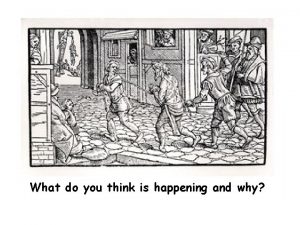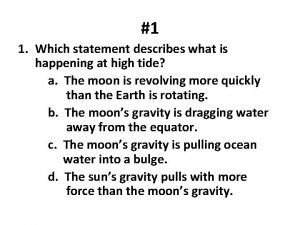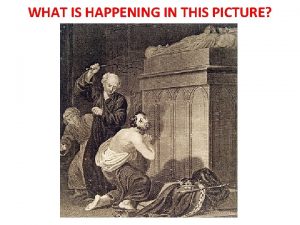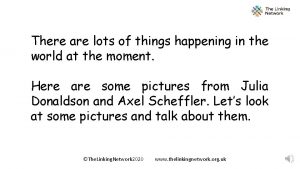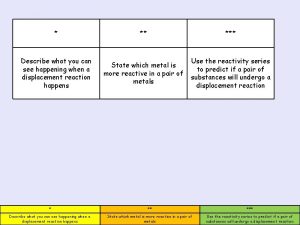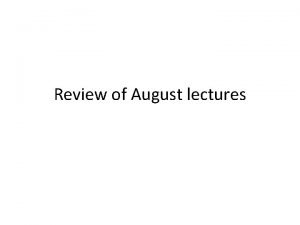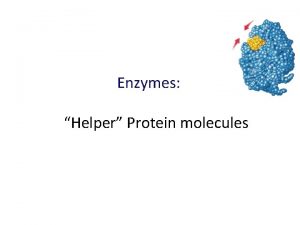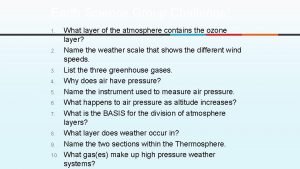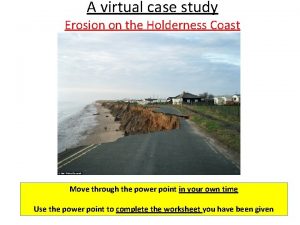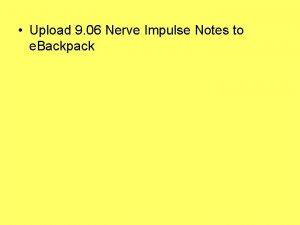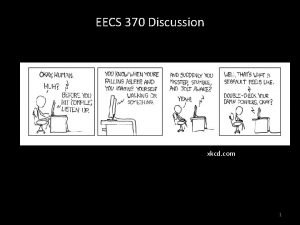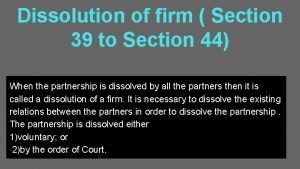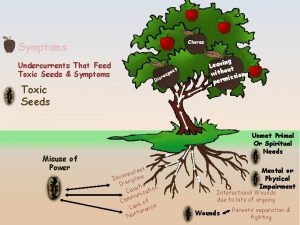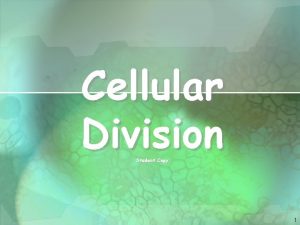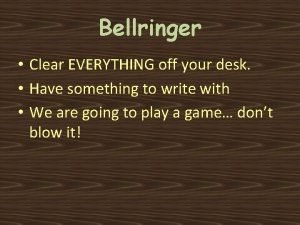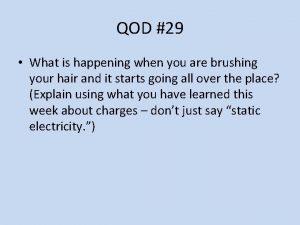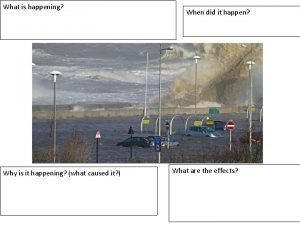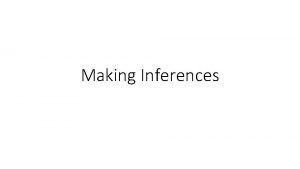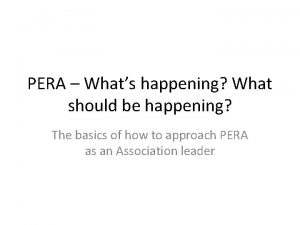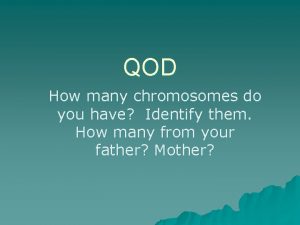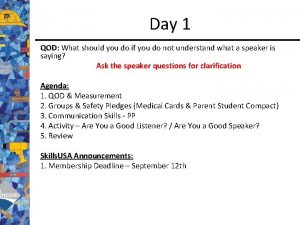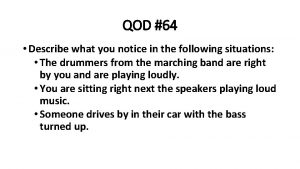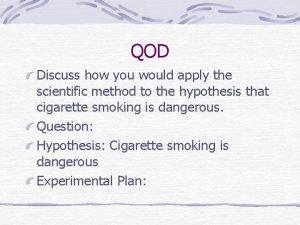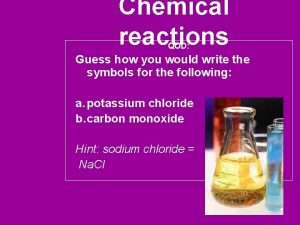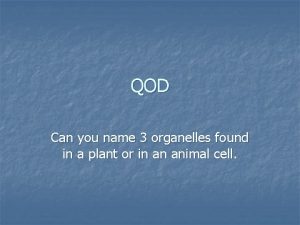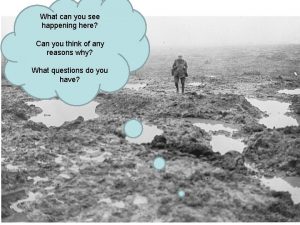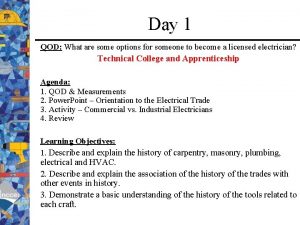QOD 29 What is happening when you are






































- Slides: 38

QOD #29 • What is happening when you are brushing your hair and it starts going all over the place? (Explain using what you have learned this week about charges – don’t just say “static electricity. ”)

Circuits Electric Circuits – a complete, closed path through which electrons can flow. • Glue in “Secret Language” Handout

Activity #1: Simple Circuit Draw at least one of your circuits.

Conductors of Electricity? Materials 1. Straw 2. Aluminum foil 3. Paper clip 4. Copper nail 5. Glass 6. Fleece 7. Pencil lead 8. Penny 9. Brass fastener 10. Tooth pick Prediction (yes or no) Insulator or Conductor

Conductors of Electricity • Conductors – transfer electrons through it easily • Insulators – do not transfer electrons through it easily

Questions 1. Which materials conducted an electric current? 2. Why do we use a conductor in an electric circuit?

Switches 1. Follow the directions to make a switch with your partner. Materials: notecard, paper fasteners, paper clip, tape 2. Add the switch to a simple circuit and turn the light bulb on and off with the switch. 3. Draw a diagram of the circuit with a switch in your notebook.

QOD #30 • Draw a diagram of a simple circuit with the switch open and one with the switch closed. Circle the drawing where the bulb would be lit.

Draw Circuit Configurations 1. Make a simple circuit to light up a light bulb. Draw a diagram of this working configuration. Label each part. 2. Make a more complex circuit which lights up one or more light bulbs. Draw a diagram of this working configuration. Label each part. 3. Make a different complex circuit. Draw a diagram of this working configuration. Label each part.




1. Series Circuit An electric circuit with only one path for an electric current to flow.

2. Parallel Circuit An electric circuit with more than one path, or branch, for an electric current to flow.

1. Create a series circuit. 2. Unscrew one of the light bulbs. What happened? Why does this happen?

3. Create a parallel circuit. 4. Unscrew one of the light bulbs. What happened? Why does this happen?

Day 3

QOD#73 Draw an electrical diagram of the following circuit. Label the different parts.

Types of Circuits Challenge: Start with a circuit with 2 light bulbs. Create a way for one light bulb to be turned off (or unscrewed) while the other stays on.


Examples Disadvantages Advantages Series Circuits Parallel Circuits


Batteries have three parts, an anode (-), a cathode (+), and the electrolyte, a liquid or solid separating them. The electrolyte in the battery keeps electrons from going straight from the anode to the cathode within the battery. When the + and – ends are connected with wire, electrons can easily flow from anode to cathode. Batteries convert chemical energy to electrical energy. Wet and dry cells are classified by the type of electrolyte the battery uses. The electrolyte of a cell may be a liquid or a paste. If the electrolyte is a paste, the cell is referred to as a dry cell. If the electrolyte is a solution, the cell is called a wet cell.

Dry Cell Battery


Wet Cell Battery

Lemon Battery (Wet Cell)

Day 4

QOD#34 Explain how the two types of circuits are different.

QOD#79 Explain how a light switch works. (Be specific about when a switch is open and closed. )

3 -15 -13 Light Bulb Filament A filament is the little wire inside of a light bulb, with a high melting point, that glows and gives off visible light.

Making a Filament Lab 1. Follow the directions of the hand out to make a filament. 2. Safety: – The nichrome wire is thin and can cut the ends of your fingers if you pull it too hard. – Make sure the wires to your batteries are disconnected while wrapping the nichrome wire. – Do not touch the nichrome wire once the circuit is closed. It gets very hot! You can burn yourself! 3. Draw a picture of the set up required to make a filament. Label the parts. 4. Clean Up: We are going to re-use the nichrome wire. When directed, please straighten out the nichrome wire so we can re-use it for the next classes.


Types of Light Bulbs • Light Emitting Diodes (LEDs) – Ex: light up numbers on digital clocks, traffic signals • Incandescent Light Bulbs – produces light with a filament • Compact Fluorescents (CFLs)

Pros & Cons of Different Types of Lights Types of Pros Cons Light Emitting Diodes (LEDs) Incandescent Light Bulbs Compact Fluorescents (CFLs)

Make a Claim – Paragraph Write a paragraph about which type of light bulb you would recommend using based on the positives and negatives you listed. Give support for your reasoning based on the specifics from the comparison chart.

3 -11 -13 QOD#31 Mrs. Schneider and her husband use about 300 kilowatt-hours (k. Wh) in a month at their house. If we pay 10 cents per k. Wh, how much is the electricity bill? $30. 00

11: 08 pm Sunday Night 11: 00 pm Saturday Night 1, 915 k. Wh – 1, 903 k. Wh = 12 k. Wh used in 24 hours How much did it cost? $1. 20
 Antigentest åre
Antigentest åre Qod drug
Qod drug What do you think is happening in the picture
What do you think is happening in the picture What do you think is happening in this picture
What do you think is happening in this picture Clapper dudgeon
Clapper dudgeon Good hazard scenarios describe where it is happening
Good hazard scenarios describe where it is happening Swiss snow happening 2023
Swiss snow happening 2023 Happening umjetnost
Happening umjetnost Performance happening
Performance happening Questions a
Questions a What is happening in this picture
What is happening in this picture What is happening in this picture
What is happening in this picture Waning crescent
Waning crescent What is happening in the picture answer
What is happening in the picture answer Picture with lots of things happening
Picture with lots of things happening Performance happening
Performance happening Happening art
Happening art What is happening in the picture
What is happening in the picture Who was she? where was she? what was happening?
Who was she? where was she? what was happening? Whats happening in this photo
Whats happening in this photo Frontal lifting
Frontal lifting Whats happening to ellie
Whats happening to ellie What is happening in this photo
What is happening in this photo Beach food chain
Beach food chain Vitality
Vitality Whats happening out there
Whats happening out there Nerve impulse animation
Nerve impulse animation Whats happening in this picture
Whats happening in this picture Happening body art
Happening body art What is happening in this picture
What is happening in this picture Eecs370 project 3
Eecs370 project 3 Disney dna quiz
Disney dna quiz Dissolution on the happening of certain contingencies
Dissolution on the happening of certain contingencies What's happening here
What's happening here What is happening in this picture
What is happening in this picture What is happening in this picture
What is happening in this picture What is happening in the picture
What is happening in the picture Amsterdam bar association
Amsterdam bar association Aci asq
Aci asq




